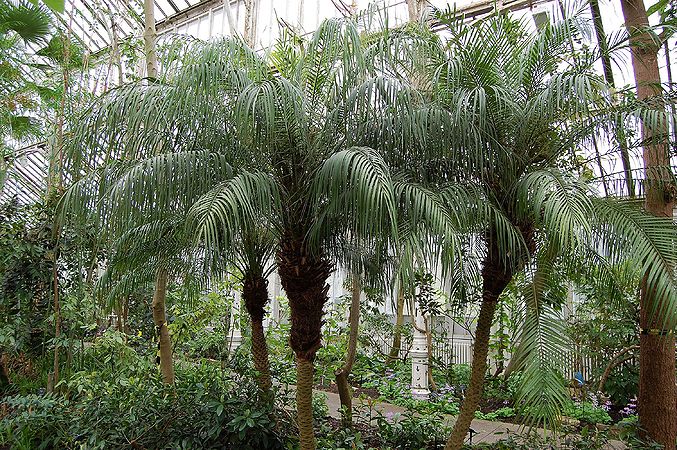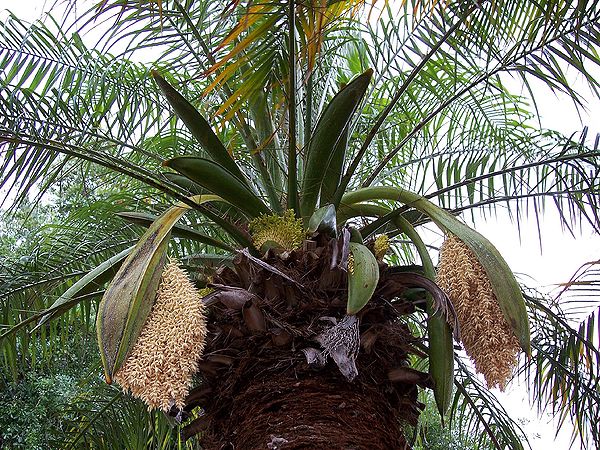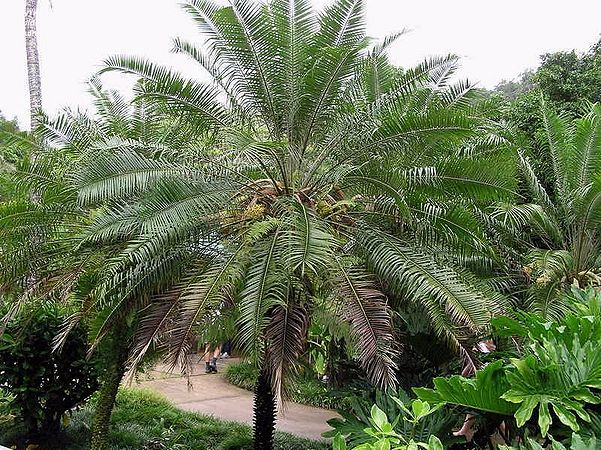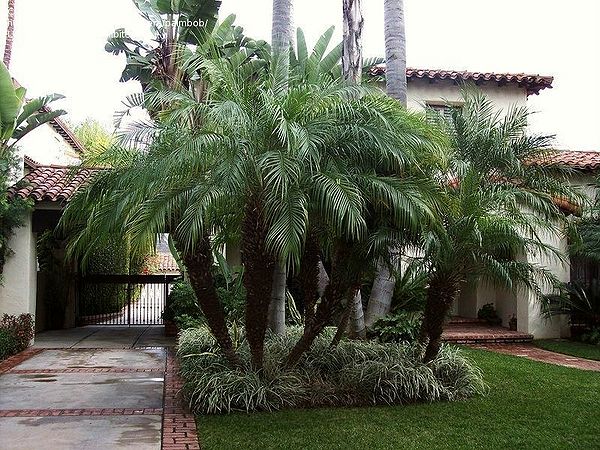Phoenix roebelenii
| Phoenix (FEH-niks) roebelenii (roh-behl-LEHN-ee) | ||||||||
|---|---|---|---|---|---|---|---|---|
 Photo by fleurone | ||||||||
| Scientific Classification | ||||||||
| ||||||||
| Synonyms | ||||||||
|
| ||||||||
| Native Continent | ||||||||
|
| ||||||||
| Morphology | ||||||||
| ||||||||
| Culture | ||||||||
|
| ||||||||
| Survivability index | ||||||||
|
| ||||||||
| Common names | ||||||||
|
| ||||||||
Contents
Habitat and Distribution
China South-Central, Laos, and Vietnam. Northern Laos (Nam Ou valley), Vietnam (Upper Black R. region near Lai-Chau), and southern China (Xisuangbanna region of Yunnan), most notably along the banks of the R. Mekong. Closely associated with riverside or cliff habitats where it grows as a rheophyte. The rheophytic habit is rare within the palm family (Dransfield 1992). The clustering habit of R roebelenii may help it to survive flooding. (S.C. Barrow. 1998)/Palmweb.Description
The pygmy date palm is one of the most popular small landscape palms in Florida. It is single-stemmed, but is often grown in clumps of 2–4 closely spaced individuals which, when older, give the impression of a multi-stemmed palm (Figure 1). It grows to a height of about 12 ft with a spread of 6–8 ft. The feather-shaped (pinnate) leaves have slender petioles and basal leaflets that are modified into sharp 2–3 inch long spines. The slender, often crooked trunk varies in diameter from 3–6 inches and is covered with distinctive peg-like leaf bases (Figure 2). Older specimens will have a large mass of aerial root initials at the base of the trunk. Cream-colored male and female flowers are found on separate trees (dioecious) in the spring that are followed by small elongated reddish-brown fruits that turn black upon ripening. (Dr. Timothy K. Broschat - edis.ifas.ufl.edu)
In its natural environment Pygmy Date Palm has a single-trunk, but in cultivation it is usually planted with 3-5 specimens. When planted in clumps, the trunks tend to curve gracefully away from the center of the clump creating an especially attractive arrangement.
The Pygmy Date Palm trunk is covered with old leaf scars and topped with pinnate, or feather like, leaves which grow to about 4ft in length. Leaves are bright green, droopy covered with 4-5 in leaflets that are modified into 2-3 in. sharp spines at the base of the petiole. Be careful while pruning it and keep kids away.
Flowers/Fruits: During spring, the Pygmy Date Palm produces beautiful creamy flowers that are held by 1ft long stalks. The Pygmy Date Palm is dioecious, male and female flowers grow on separate plants. Between september and october, flowers are followed by small dates. It usually has about 10 -13 long fruit clusters hanging below the leaves. Fruits are elliptical, 1/2 inch long and turn red-brown to dark purple when ripe. The date is mostly seed with only a thin layer of fruit. (florida-palm-trees.com)
| Detailed Scientific Description |
|---|
|
Clustering palm (often solitary in cultivation), forming clumps with stemless plants suckering at base of taller stems. Stem 1 - 2 m (rarely 3 m) high, without sheaths to 10 cm in diam., erect or twisted, pale, becoming smooth with age, marked with diamond-shaped persistent leaf bases each with a central bump of remnant vascular tissue; stem base developed with a root boss; roots occasionally emerging from stem above ground level. Leaves arching, 1 - 1.5 (2) m long; pseudopetiole to about 50 cm long; leaf sheath reddish-brown, fibrous; acanthophylls arranged singly or paired, about 12 on each side of rachis, orange-green, to 8 cm long; leaflets regularly arranged, opposite, about 25 - 50 on each side of rachis, linear, concolorous, deep green, often flaccid, to 40 x 1.2 cm; lamina with discontinuous white scurfy ramenta along abaxial veins and midrib, almost totally covering abaxial surface of unexpanded (sword) leaves. Staminate inflorescences pendulous; prophyll coriaceous, two-keeled, splitting once abaxially between keels, about 30- 60 cm long; peduncle to 30 cm long; rachillae 7- 20 cm long. Staminate flowers with calyx a three-pointed cupule, 1.2 mm high, yellow- white; petals pale yellow-white with acuminate apices and with jagged margins, 7 - 8 x 2 - 2.5 mm; anthers 3.5 - 4 mm long. Pistillate inflorescences erect, arching as fruits ripen, up to 35 cm long; prophyll coriaceous, two-keeled, to 35 cm long x about 5 cm wide, splitting once adaxially between keels to reveal inflorescence; peduncle green, to about 30 x 3 cm; rachillae with bulbous bases, orange-green, occasionally branched to one order, subtended by papery bracts (about 4 cm long). Pistillate flowers pale green, arranged in distal three quarters of rachilla, subtended by papery bracts to 5 mm long; calyx a three-pointed cupule, thickened and ridged up to apices, striate, 2 - 2.5 mm high; petals 3.5 x 4 mm with acute apices; generally only one carpel reaching maturity. Fruits obovoid, with persistent perianth, maturing from dark green to purplish brown, 13 - 18 x 6 - 7 mm; stigmatic remains apical, 1 mm long, orange- brown, often recurved. Seed narrowly elongate, terete, with rounded apices, 7 - 3 mm; embryo lateral opposite raphe; endosperm homogeneous. (S.C. Barrow. 1998)/Palmweb. Editing by edric. |
Culture
| read more |
|---|
|
Growth Rate: Slow to Moderate. Phoenix roebelenii is a small palm that can grow up to 5 – 10 ft tall and 1-5 ft wide, but usually doesn’t grow more than 7 ft. Very adaptable to most soils (use light, fast draining soils in containers). Fertilize 3 times a year. Light: Bright sun to partial shade, in FL. half a day full sun will produce a softer, darker appearance. Water Req: Moderate. Needs adequate moisture for best look. Adapts to all king of soil. It has some drought tolerant but does well in moist well drained soil. Hardiness: Phoenix roebelenii is a cold hardy palm that can tolerate cold down to 15 F when mature enough. It is great for USDA Zones 8b Propagation: Propagated by seed that takes around 3-4 months to germinate. The best conditions for germination would be warm moist soil with enough shade to protect young seedlings from direct sunlight. Pygmy date palms are adaptable to a wide range of soil types. They are considered to be cold hardy to USDA zone: 8b. They are not tolerant of salt spray or saline soils. Most pygmy date palms in Florida exhibit potassium (K) deficiency symptoms on their oldest leaves. Symptoms are most severe towards the tips of affected leaves and appear as a yellow-orange discoloration of the leaflets and necrosis of the leaflet tips (Figure 3). Potassium deficiency also causes premature leaf death, so K-deficient palms retain fewer leaves than healthy ones. Potassium-deficient leaves, though unsightly, should not be removed until they are completely dead, as they serve as a supplementary source of K in the absence of sufficient K in the soil. Proper fertilization will gradually increase the number of leaves in the crown. Once a fully round crown has been achieved, visible symptoms of K deficiency will also begin to disappear. Landscape palm fertilizers should have an analysis of 8-2-12 (or 8-0-12) with 100% of the nitrogen (N), K, and magnesium (Mg) in controlled release form, and micronutrients such as manganese (Mn) and iron (Fe) in water soluble (sulfate or chelate) form in order to be effective. For more information about K deficiency and fertilization of landscape palms in Florida. (edis.ifas.ufl.edu) |
Comments and Curiosities
| read more |
|---|
|
Conservation: A naturally restricted distribution, habitat loss and a horticultural trade in wild-collected plants may mean that the wild populations of P. roebelenii merit 'vulnerable' status, but further studies are needed. Demand for P. roebelenii as an ornamental is mostly met through seeds and offshoots from cultivated plants. However, Barrow (1994) suggested that collection of mature palms from the wild poses an increasing threat. (S.C. Barrow. 1998) Uses: Since its introduction to Europe, P. roebelenii has become a popular and widely cultivated ornamental palm and is now found in private and botanical gardens around the world. (S.C. Barrow. 1998)/Palmweb. "This is one of the most commonly grown palms in malls and public plantings in Southern California. It is hardy, despite its origins in tropical Asia, and is one of the more 'user friendly' Phoenix palms, having soft, feathery leaves. However, it still has some sharp, 1-2" spines at the base of each leaf, so careful when pruning. It is actually, for a palm, one of the faster growing palms in Southern California. Though it is the pigmy of the Phoenix, it can grow up to 15' tall (may take 20-30 years to get that tall, though). It is usually not clustering, but sold in clumps, making it look that way." (Geoff Stein) |
- IMAGE GALLERY
External Links
- Glossary of Palm Terms
- MODERN BOTANICAL LATIN
- "Just To Be Clear"
- https://youtu.be/nVCxAD9hjtA
- https://youtu.be/8H24H5mXFb0
- http://www.photomazza.com/?Phoenix-roebelenii
- http://idtools.org/
References
Phonetic spelling of Latin names by edric.
Special thanks to Geoff Stein, (Palmbob) for his hundreds of photos.
Special thanks to Palmweb.org, Dr. John Dransfield, Dr. Bill Baker & team, for their volumes of information and photos.
Glossary of Palm Terms; Based on the glossary in Dransfield, J., N.W. Uhl, C.B. Asmussen-Lange, W.J. Baker, M.M. Harley & C.E. Lewis. 2008. Genera Palmarum - Evolution and Classification of the Palms. Royal Botanic Gardens, Kew. All images copyright of the artists and photographers (see images for credits).
S.C. Barrow, A Monograph of Phoenix L. (Palmae: Coryphoideae). 1998. A Monograph of Phoenix L. (Palmae: Coryphoideae). Kew Bulletin, Vol. 53, No. 3 (1998), pp. 513-575.
Many Special Thanks to Ed Vaile for his long hours of tireless editing and numerous contributions.










































































